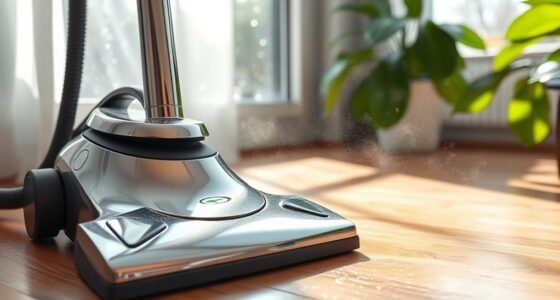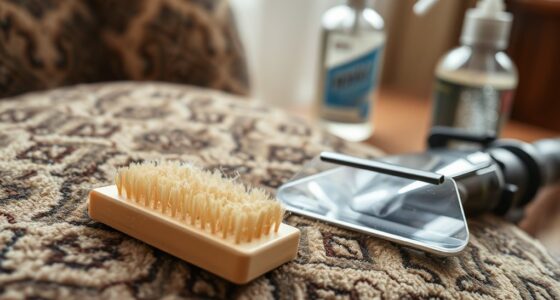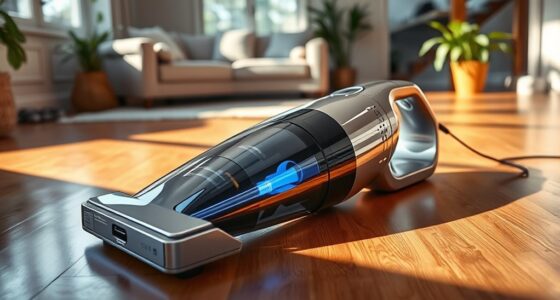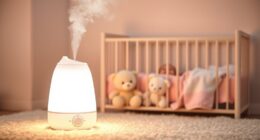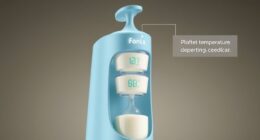If you want to reduce allergens in your home, vacuuming with a HEPA filter is far more effective than sweeping. Vacuuming pulls allergens like dust mites, pet dander, and pollen from deep within carpets and upholstery, trapping them inside the machine. Sweeping, on the other hand, often stirs up dust into the air, making allergy symptoms worse. To create a healthier space, switching to regular vacuuming is a smart step—there’s more to discover below.
Key Takeaways
- Vacuuming with HEPA filters removes allergens from deep within carpets and upholstery, unlike sweeping which stirs them into the air.
- Vacuuming traps airborne allergens immediately, reducing respiratory irritation compared to dust dispersal caused by sweeping.
- Regular vacuuming decreases dust mites, pet dander, and pollen embedded in fibers, helping manage allergy symptoms more effectively.
- Sweeping can worsen allergies by dispersing dust and allergens into indoor air, whereas vacuuming minimizes airborne particles.
- Combining vacuuming with air purifiers enhances air quality and provides a more comprehensive allergy management strategy.

When it comes to managing allergies at home, choosing the right cleaning tool makes a considerable difference. You might think sweeping with a broom is enough to keep your space allergen-free, but in reality, vacuums often do a better job of capturing airborne and settled allergens. Air purifier benefits become even more noticeable when combined with effective vacuuming, as it helps reduce particles that linger in the air. Brooms tend to stir up dust and allergens into the air rather than remove them, which can worsen allergy symptoms. A vacuum, especially one equipped with a HEPA filter, pulls allergens out of carpets, rugs, and upholstery, trapping them inside so they don’t float back into your environment.
Vacuuming with a HEPA filter outperforms sweeping for allergy relief.
If you’re dealing with carpets, understanding carpet cleaning tips is essential. Regular vacuuming with a high-quality machine can remove deeply embedded dust mites, pet dander, and pollen that brooms often leave behind. Brooms only sweep surface debris and can push allergens around, while vacuum cleaners with powerful suction lift allergens from deep within fibers. This makes vacuuming a more thorough cleaning method, especially in high-traffic areas where allergens tend to accumulate. However, not all vacuums are created equal. Choosing one with a sealed system and HEPA filtration guarantees that allergens are captured and contained, rather than released back into the room.
An additional benefit of vacuuming over sweeping is that it creates less airborne dust during cleaning. When you sweep, tiny particles become airborne, which can aggravate allergies and respiratory issues. Vacuuming minimizes this disturbance because it traps particles immediately, preventing them from dispersing into the air you breathe. For best results, vacuum regularly—at least twice a week—and focus on common allergen hotspots like carpets, rugs, and upholstered furniture. Remember to empty the vacuum bag or canister frequently to prevent it from becoming a source of re-contamination.
Incorporating a good vacuuming routine alongside an air purifier can considerably improve indoor air quality. While air purifiers filter out airborne allergens, vacuuming removes the ones settled in your home’s surfaces. Together, they create a cleaner, healthier environment. Recent research also emphasizes that AI safety measures are essential for developing reliable and secure cleaning technologies. If you’re committed to reducing allergy symptoms, switching from broom to vacuum isn’t just a matter of convenience—it’s a strategic move to better control airborne irritants. You’ll notice fewer sneezes, less nasal congestion, and clearer breathing, making your home a more comfortable space for allergy sufferers.
Frequently Asked Questions
Do Vacuum Cleaners Remove Pollen Better Than Brooms?
Yes, vacuum cleaners remove pollen better than brooms. They use electrostatic attraction to trap pollen particles, preventing airborne dispersal. Unlike brooms, which can stir up pollen and spread it around, vacuums suck allergens directly into the filter, reducing overall airborne pollen levels. This makes vacuums more effective for allergy relief, especially when equipped with HEPA filters, ensuring cleaner indoor air and less allergen exposure.
Can Vacuums Help With Pet Dander Allergies?
Absolutely, your vacuum’s a hero in the battle against pet hair and dust mites. It actively sucks up allergens hiding in carpets and upholstery, unlike a broom that merely pushes them around. While it’s not a miracle worker, a good vacuum with HEPA filters considerably reduces pet dander, giving allergy sufferers a chance to breathe easier. So, yes, vacuuming is your best weapon in managing pet allergy symptoms at home.
Are There Specific Vacuum Filters Recommended for Allergy Sufferers?
Yes, allergy sufferers should look for vacuums with HEPA filters or allergy-specific vacuums. HEPA filters trap tiny allergens like pet dander and dust mites, preventing them from recirculating into the air. Allergy-specific vacuums are designed to maximize allergen removal, making your space safer. Always check that the vacuum has a sealed system and a HEPA filter to guarantee superior allergen capture and improve your indoor air quality.
How Often Should I Vacuum to Reduce Allergens Effectively?
You should vacuum at least twice a week to reduce allergens effectively. Regular vacuum maintenance guarantees your vacuum operates efficiently, preventing allergen accumulation in the filter and bag. More frequent vacuuming is beneficial if you have pets or allergies, as it minimizes dust, pet dander, and other irritants. Consistent cleaning keeps allergens at bay, helping you breathe easier and maintain a healthier indoor environment.
Do Wet Mops Outperform Brooms in Allergen Removal?
Wet mops win when it comes to wiping out allergens, outperforming brooms in allergen trapping. Mopping not only cleans surface grime but also captures and locks in dust, pollen, and pet dander, reducing airborne allergens. By thoroughly mopping with a damp cloth, you prevent allergens from spreading, creating a cleaner, healthier home environment. So, if you’re battling allergies, a good wet mop beats a broom every time.
Conclusion
So, if you’re serious about scrubbing away sneezing triggers, a vacuum’s vacuuming wins. It traps tiny allergens, leaving your space cleaner and your lungs lighter. Brooms simply brush past bothersome particles, allowing allergens to linger. Choosing cleaning over sweeping guarantees your environment’s allergy-free, offering relief and reassurance. Make the smart switch today—sweep less, vacuum more—so you can breathe better and live comfortably. Your allergy-aware abode awaits, all thanks to the power of proper cleaning!



